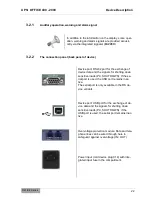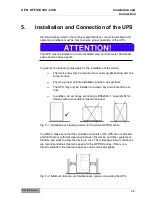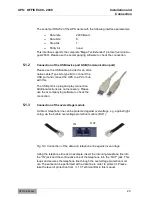
UPS: OFFICE 400 - 2000
Device Description
OFFICE Series
18
3.
UPS device description
Sensitive loads require comprehensive protection against supply disruption.
This includes: temporary mains failure, mains voltage fluctuations, mains volt-
age peaks, frequency changes, etc. The uninterruptible power supply unit is in-
tended to support mains-supplied, sensitive electronic devices such as: comput-
ers, workstations, cash registers, operation-critical instruments, telecommunica-
tion devices, process control systems, etc. against supply disruptions. In doing
so, the UPS supervises the above mentioned network sizes and supports the
loads in critical moments. The support time, or autonomous duration, is depend-
ent on the size of the installed or adapted energy storage (accumulator).
3.1
Topology and operation modes
In the OFFICE series, there is a so-called
“LINE INTERACTIVE” or “OFFLINE”
setting. This is identified in that the load is directly supplied by the mains power
supply in standard mode (
Mains operation
) (see Fig. 3-1). Light mains voltage
fluctuations are then equalized by the AVR (AUTOMATIC VOLTAGE REGULA-
TION) so that a load operation is ensured to always remain in the standard
mains voltage range.
Fig. 3-1 Block diagram or setup of the OFFICE series.
In the event of a massive mains fault, the switching unit turns on in the
Inverter
mode
(Inverter operation or autonomous mode). The loads will only be operated
directly via the inverter for the duration of the fault. The inverter draws the nec-
essary power from the accumulator during this autonomous period. Once the
mains fault / mains failure has passed, the switching unit switches again to
mains operation.
As long as the device it connected to the mains power supply, the charging unit
of the accumulator is being charged (
Charging mode
). The maximal autono-
mous duration for the UPS is dependent on both the charging status and the ca-
pacity of the accumulator. Please see the section on technical data in this oper-
ating manual for details.
















































